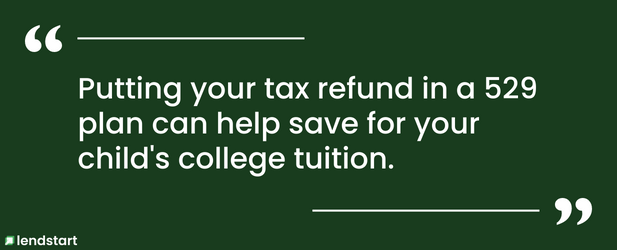
Receiving your tax refund from the IRS can bring a much-needed lift to your financial situation.
As of May 2023, the IRS reports the average annual tax refund is $2,812. Regardless of your filing status and whether your tax refund is bigger or smaller than previous years, using your income tax refund wisely can help you make the most of it. This article will tell you how to do that.
6 Ways to Use Your Tax Refund for Financial Stability
We've outlined several suggestions for this year's tax return, including how you can turn it into more money and some of the considerations that can dictate your next move with your tax return.

1. Pay Down High-Interest Debt
One of the smartest things you can do with this year's tax refund is to pay off high-interest debt. Paying off this type of debt, like credit cards, can save you a lot of money down the road and help you gain control of your finances.
For credit cards with high-interest rates, using your tax refund to pay it off could result in hundreds or even thousands of dollars saved over time. Even if it doesn't eliminate this debt, reducing your balance will make paying down the rest easier.
Check out our Guide for Overcoming Credit Card Debt.
2. Contribute to Your Emergency Fund
Almost all professional advice you receive for financial purposes will tell you to establish an emergency fund. These savings can be valuable in times of need, including any unanticipated expenses or life changes, such as job loss, car accidents, or medical bills.
Putting part of your tax refund towards your emergency fund can provide peace of mind and long-term stability for you and your family. It's ideal to build up at least six months' worth of living expenses in your emergency fund, but start small and increase the amount over time.
It's also important to keep this money in a liquid account, such as a high-interest savings or other bank account, so you can access it when needed. Again, high interest is key here because this helps you earn more money off of your money.
3. Save for Retirement
It's never too early to start saving for retirement. Even if it may be decades away, investing now and taking advantage of compound interest can make all the difference in your golden years. Consider taking your 2022 tax refund and investing it into an IRA or other retirement account.
The amount you put in today can come back to you with interest once you're ready to retire. Plus, depending on your account type, some or all of the money may be tax-deductible now.
One common option is a tax-free IRA, such as a Roth IRA. With Roth IRAs, you pay taxes on the funds upfront, and then they can grow tax-free for retirement. Ultimately, this can turn into even more money in your pocket come retirement time.
Keep in mind, this money needs to be in this account for five or more years to qualify as tax-free upon withdrawal.

4. Set Aside for Your Kids' College
You can also use your 2022 tax refund to help your children pay for college. Setting aside funds now, even if just a small amount, can add up quickly and make a difference when the time comes.
You can open different types of accounts specifically for this purpose, such as 529 plans and Coverdell Education Savings Accounts. They generally have higher contribution limits than IRAs or retirement savings accounts, and they come with special features that make them more advantageous for college tuition expenses.

Effect of Tariffs on Businesses and Consumers: A Look at the Pros and Cons

Understanding the 2025 Tax Bracket and Standard Deductions
5. Invest in Self-Improvement
If your federal tax refund status says you're getting money back this year, another clever option is using this money to invest in self-improvement.
Depending on your goals, there are all kinds of ways to do this.
- Gym membership: If you're trying to get in shape, a gym membership could be the perfect way to use your refund. Healthier habits can have long-term positive effects, both physical and mental, so this is an investment that yields high returns.
- Professional certifications: Obtaining certifications or other qualifications related to your field can help you reach new career levels and earn more money in the future. Again, this is another investment that can pay off in spades in ways you might not expect.
- Medical and dental work: If your dental or healthcare plan doesn't cover the cost of certain procedures, your tax refund can come in handy.
- Plan a vacation: If your basic financial needs are met, you have investments you're confident in, your emergency fund is topped up, and your high-interest debt is paid off, consider using your tax refund status for a vacation or other restorative activity.
- Start a side business: Perhaps you've been thinking of starting an online store to sell the pottery you make, or you have another side business you're eager to start. This year's tax return could be an investment in that business.
6. Consider the Stock Market
Finally, investing in the stock market is one of the most common ways to use a tax refund. Investing, when done right, builds wealth over time. With compound interest, even small contributions can become large sums down the road.
Mutual funds and exchange-traded funds (ETFs) are well-known options because they diversify your investments across many different stocks, reducing risk. Index funds are also a good option for beginners as they track an index such as the S&P 500 and are less risky than individual stocks.
Do research on investing strategies before committing any money so you can make informed decisions. Keep in mind, diversifying investments is often the best route. But, as they say, don't put all your eggs in one basket.
How to Get Your Tax Refund
Knowing your refund status is one thing, but getting that money in your bank account is the crucial next step. Usually, you'll get your refund in your bank account within 21 days of filing your tax return, and there are a few different ways it can come to you, including:
- Direct deposit into your bank account
- Paper check sent to the mailing address on your return
- Deposited into your IRA account
- US Savings Bond
To track the progress of your refund status, you can use IRS tools like IRS2Go and "Where's My Refund?" so you know exactly when it will arrive in your bank account. Knowing how to get and use your tax refund can help ensure this money works for you in the best way possible.
So do your research, plan, and start thinking about how to use your tax refund most advantageously.

Conclusion
Whether you decide to save your tax refund for a rainy day, invest it, or pay off debt, what matters is you use your tax return to improve your financial situation in some way. Consider your long-term goals, and ensure you're taking steps to achieve them.
With thoughtful planning, your tax refund can be a great investment in your future. That's the power of using your tax refund to secure your financial stability.
Article Topics










